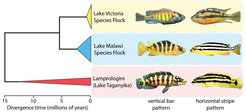Molecular mechanisms of the repeated evolution of adaptive color patterns in cichlid fishes

Abstract: Coloration is an important feature in the biology of an organism and plays a key role in several fundamental ecological and evolutionary processes such as adaptation, sexual selection and speciation. Moreover, conspicuous pigmentation phenotypes challenge molecular and developmental biologist to try to understand their origin during the development of an organism. Fish are well known for this diversity of color patterns. Cichlid fishes (Cichlidae) are a particular colorful family of fishes. Many of the color patterns we find in cichlids have evolved repeatedly in different species. Yet, still little is known about the genetic changes that are necessary to generate these traits.
The proposed project will focus on the repeated adaptive evolution of stripe patterns within cichlids. Here, horizontal stripe and vertical bar patterns occur and evolved repeatedly in different lakes in the African Rift Valley. These are driven by ecological adaptations to similar habitat environments. We are looking for a PhD student who is interested in genetic [e.g. QTL (Quantitative Trait Loci) mapping], genomic (targeted genome sequencing) and state-of-the-art molecular and developmental biology approaches (in situ hybridization, transgenesis, genome editing and chromatin immunoprecipitation). The aim of the project will be to analyze the genetic and molecular basis of an ecologically well-described adaptive phenotype that evolved repeatedly within short evolutionary times. The project gives a unique opportunity to provide the first clear insight into the genomic substrates of the repeated evolution of an adaptive trait in this famously diverse family of fishes.
Key words parallel evolution, coloration, cichlid fishes, forward genetics, evo-devo
Main advisor Axel Meyer + Claudius Kratochwil, University of Konstanz
